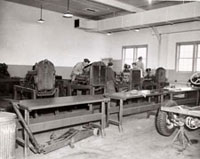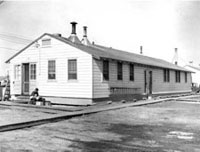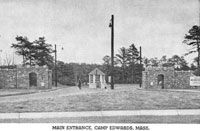Cultural Resources
 Cultural Resources include archaeological sites, historic buildings, structures (e.g., bridges), and objects (e.g., tanks, planes, ships); artifact and document collections; historic landscapes; and Native American sacred sites and properties of traditional, religious, and cultural significance. The role of the Cultural Resources Manager is to maintain an inventory of all cultural resources present on lands owned or leased by the Massachusetts Army National Guard (MAARNG), ensure that all actions that might impact those resources occur in compliance with federal and state legislation; and generally, balance the needs of preservation with those of training our soldiers.
Cultural Resources include archaeological sites, historic buildings, structures (e.g., bridges), and objects (e.g., tanks, planes, ships); artifact and document collections; historic landscapes; and Native American sacred sites and properties of traditional, religious, and cultural significance. The role of the Cultural Resources Manager is to maintain an inventory of all cultural resources present on lands owned or leased by the Massachusetts Army National Guard (MAARNG), ensure that all actions that might impact those resources occur in compliance with federal and state legislation; and generally, balance the needs of preservation with those of training our soldiers.
Historic Buildings, Structures, and Objects:
The MAARNG currently maintains 54 facilities across the state. Buildings on these facilities were constructed as early as the 1880s and range from elaborate armories to World War II temporary structures to modern concrete and glass buildings. Two of our armories have been listed on the National Register of Historic Places, 14 others have been evaluated as eligible for listing, and the remaining buildings are being evaluated as they reach 50 years in age or are determined to have significance as Cold War construction. Historic districts have been defined for the MAARNG's Natick (Speen Street) facility, and for the portions of the Camp Curtis Guild cantonment area constructed between 1905 and 1946.
 At Joint Base Cape Cod (JBCC), historic buildings surveys have been completed for all buildings over 50 years of age. Eligible buildings on the Camp Edwards' portion of the JBCC include Building 102 (former headquarters), Building 4180 (gym), the Ammunition Supply Point (historic district), and the Range Control complex (historic district). The World War II temporary structures in the cantonment area of Camp Edwards were determined eligible for listing on the National register in 1986, and a representative sample of these structures were documented by the Historic American Building Survey as part of a Nationwide Programmatic Agreement between the Department of the Army, the Advisory Council on Historic Preservation, and the National Council of State Historic Preservation Officers.
At Joint Base Cape Cod (JBCC), historic buildings surveys have been completed for all buildings over 50 years of age. Eligible buildings on the Camp Edwards' portion of the JBCC include Building 102 (former headquarters), Building 4180 (gym), the Ammunition Supply Point (historic district), and the Range Control complex (historic district). The World War II temporary structures in the cantonment area of Camp Edwards were determined eligible for listing on the National register in 1986, and a representative sample of these structures were documented by the Historic American Building Survey as part of a Nationwide Programmatic Agreement between the Department of the Army, the Advisory Council on Historic Preservation, and the National Council of State Historic Preservation Officers.
Archaeological Sites:
 Although much of the JBCC has not been systematically surveyed for archaeological sites, the current inventory of known sites includes 23 prehistoric sites ranging in size from discoveries of single artifacts, or isolated sites, to seasonal camps located near wetlands or ponds.
Although much of the JBCC has not been systematically surveyed for archaeological sites, the current inventory of known sites includes 23 prehistoric sites ranging in size from discoveries of single artifacts, or isolated sites, to seasonal camps located near wetlands or ponds.
No detailed excavations have been carried out at these sites; however, all of the known sites are being protected from disturbance and preserved for the future. Artifacts recovered from these sites are being curated in state-approved curation facilities and/or have been repatriated under agreements with Native American groups. The single historic period archaeological site recorded at Camp Edwards is a series of rock carvings, known locally as the "Sally Pryor rocks." Carved by a hermit in the 1780s, the carvings depict a woman in profile and the letters "Sal n' Pry."
Archival Collections:
Archival collections occur at many of our facilities in the form of maps, building blueprints, troop muster rolls, photographs, and commemorative displays; a program to inventory these collections was initiated in Fiscal Year 2003. The largest and most complete collections are housed at the Massachusetts National Guard Military Museum and Archives in Worcester where they are being inventoried and curated by the MAARNG State Historian. Collections at the Museum include personal records of all soldiers ever to have served in the MAARNG; records of every unit ever to have served in the MAARNG; and records of the Adjutant General dating back to the 1700s. The Museum also features displays commemorating the Yankee Division, the MAARNG's role in the Civil War, and numerous photographs and paintings of historic events and individuals.